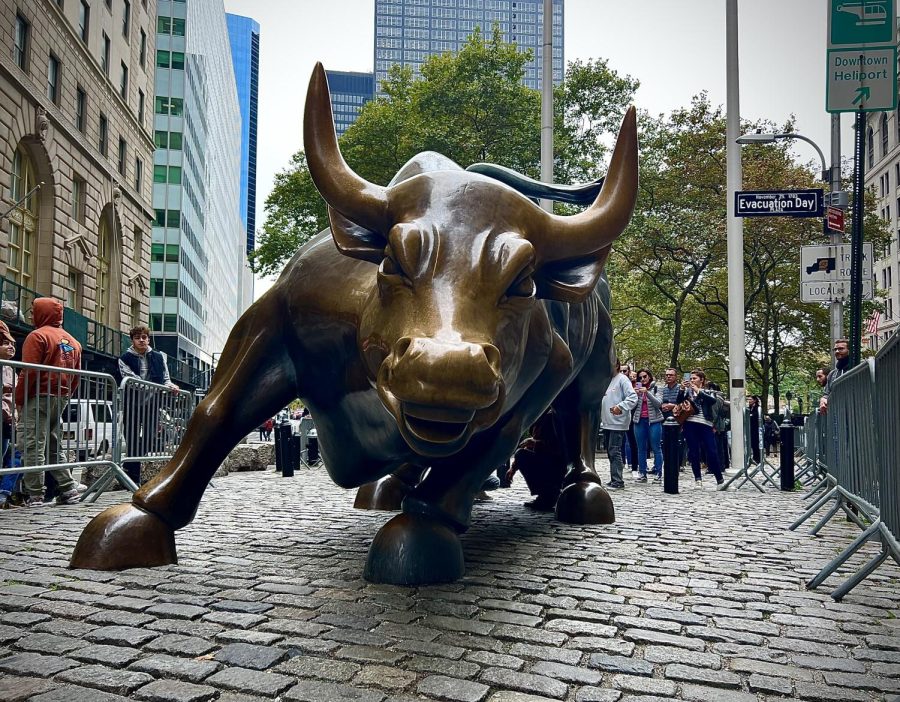Key bullish factor affects markets in the long term
November 6, 2022
Wall Street firms predict that index funds will reach annual lows. Since this prediction, a critical financial factor caused the market to grow by 5%.
The Bank of Montreal revised its prediction on the S&P 500’s performance. The original share price of $4,800 and its earnings per share of $245 decreased to $4,300 and $230, respectively. BMO’s Brian Belski told Yahoo Finance that problems with inflation were underestimated, and it seems to be a direct cause for the revision.
Goldman Sachs Group Inc. dropped its predicted price from $4,300 to $3,600. Goldman Sachs and BMO considered inflation, interest and company performance in their predictions.
As firms revise their predictions for the S&P 500, it is worth understanding the reasoning behind these decisions. Especially as more college students invest money into the major indexes due to its long term stability, amateur investors may follow these moves closely.
One financial tool that firms consider before making their S&P 500 revisions is the price-earnings ratio, which is also known as P/E. The P/E ratio divides a stock price by the earnings per share of a stock.
As of Oct. 30, the S&P 500’s P/E is currently 20.29, which is up 0.49 from September.
“At the broader S&P 500 level, we think it is important to note that market P/E [multiple] tends to exhibit moderate…expansion in the months following bear market troughs,” Belski told Yahoo Finance. “With the current bear market price low occurring on 10/12/22, the subsequent 14-month period would roughly bring us to the end of calendar year 2023.”
An increase in the P/E and in fourth quarter gains seems likely. But BMO and Goldman Sachs predicted the S&P 500 would take losses at the end of the year.
A significant factor for the growth in P/E is due to the change in earnings per share. Meanwhile, the price remains contingent on the market, as the earnings per share changes when there are speculations about it.
“A stock’s PE ratio can rise if investors believe future earnings will be higher than current levels, which is typically how ‘growth stocks’ are defined,” Robert Johnson, who is the CEO of Economic Index Associates, told NerdWallet.
Multiple long-term impacts exist due to the S&P 500’s P/E for the market. This shows a pattern of historically average trends for index funds.
“[The] future trajectory is likely to follow more normalized patterns,” Belski told Yahoo Finance. “A sharp departure from the pandemic stimulus-fueled gains of 2020-21, and the resulting YTD losses that unwound much of that excess.”
Normalized trends stabilized the market and controlled extreme gains between 2020 and 2021, allowing markets to create slow and steady long-term gains and protecting index funds from tremendous volatility.
“Despite calling for a 20% Q4, the rocket-ship-like gains we’ve gotten somewhat used to might be in the rear-view mirror,” Belski told Yahoo Finance. “Of course, that might be a healthy thing, too.”
The P/E of index funds rose from their lows in September, with the Russell 2000 Index up 72.96 and the Dow Jones Industrial Index up 20.23. This phenomenon is an indicator of future bullish market performance and stabilization. The P/E is also significant in the performances of both an index fund and a singular stock.
At universities, some students have money invested in index funds, especially in the S&P 500. This also applies to Baruch College students, especially due to the strong interest in finance and investing across the student body.
Many students may be bearish on the index fund. But this may change with the growth of index funds’ P/E and current market gains.
Students may adopt a bullish attitude toward the present situation of index fund P/E’s and their future performance to confront this.







